The cruise port in Marseille sits 3 km away from the centre, with its terminals in the Môle Léon Gourret area.
For other France cruise destinations check out our Mediterranean Cruise Ports in France page.
Getting around is simple – you can grab a taxi, hop on a shuttle, or take Metro line 2 to Joliette station.
At the terminals, you’ll find all the basics: Wi-Fi, places to change money, and spots to store your bags.
If you’re driving, there’s secure parking available round the clock, both covered and open-air.
The port puts you just a few minutes from popular spots like the Vieux-Port, Le Panier district, and Fort Saint-Jean.
Whether you’re flying in, coming by train, or driving, the port’s handy location and top-notch facilities make it brilliant for starting your Mediterranean cruise.
This guide tells you everything you should know for a hassle-free departure.
Where is The Port Located?

The cruise port of Marseille sits right by the Mediterranean in France. You’ll find the main cruise terminals at Grand Port Maritime de Marseille (GPMM), in the Môle Léon Gourret area. The port has several piers, and most cruise ships pull up to terminals J3 and J4.
It’s dead easy to get to – just 8 kilometres from Marseille-Provence Airport and roughly 3 kilometres from the centre of town. You can’t miss the Fort Saint-Jean at the port entrance – it’s a proper landmark for ships coming in. The terminals are in the Joliette area, next to La Major Cathedral and the lovely Le Panier neighbourhood. It’s brilliant for getting around on foot, with loads of local spots nearby, including the famous Vieux-Port (Old Port).
Map of Marseille Cruise Ship Port
How to get to the port, by air, train, road
Getting to Marseille’s cruise port is straightforward through three main routes. Flying in? You’ll land at Marseille Provence Airport, 27km from the port, with regular taxis and shuttles making the 25-minute trip.
Coming by train? Marseille Saint-Charles station sits just 4km from the cruise terminals. You can grab a taxi for about £17 (€20) or hop on metro line 2 to Joliette station, then it’s a quick walk to the port.
Port Parking Options
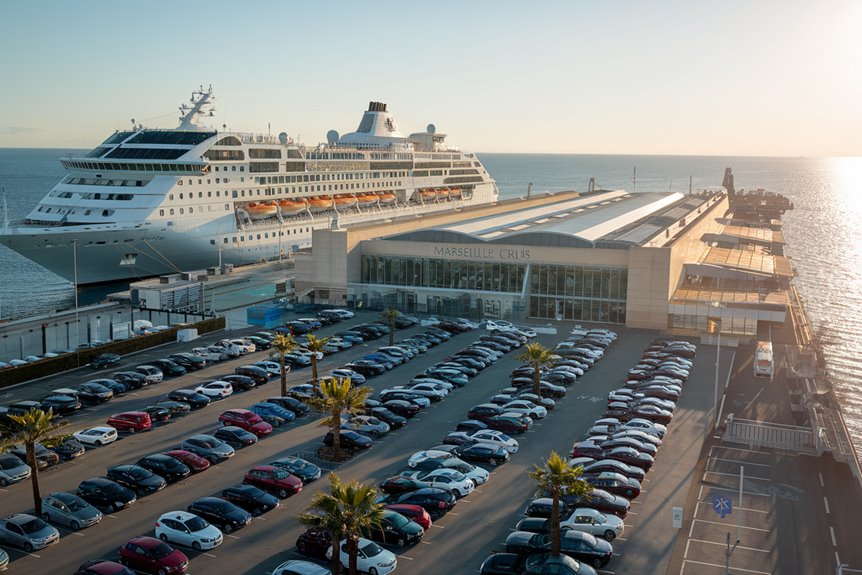
Parking at Marseille’s cruise port is simple if you’re coming by car. You can find both short-term and long-term spots within easy walking distance to the cruise terminals. The main car park, P1, has covered spaces with round-the-clock security cameras and you can walk straight to where you board.
- Get better prices and save your spot by booking through the port’s official website
- Pick between the covered main car park (£17 per day) or open-air parking in P2 (£12 per day)
- Hop on the free shuttle bus that runs every 15 minutes between the car parks and terminals when ships are boarding or letting passengers off
It’s best to book ahead, especially in busy times from June to September when spaces tend to fill up quickly.
Local Transport & Transfers
Getting to Marseille’s cruise terminals is straightforward even without a car. Regular shuttle buses run between Saint-Charles train station and the cruise port – it’s about a 20-minute journey and costs £8 each way. The metro doesn’t go right to the port, but you can hop on Line 2 to Joliette station and either walk 15 minutes or grab a taxi from there.
You’ll spot taxis at ranks across the city, and it’s roughly £50 from the airport. You can book private transport ahead through your cruise company or other transport firms. Many local hotels have their own port shuttles too – usually for a small extra charge.
Port Terminal Facilities
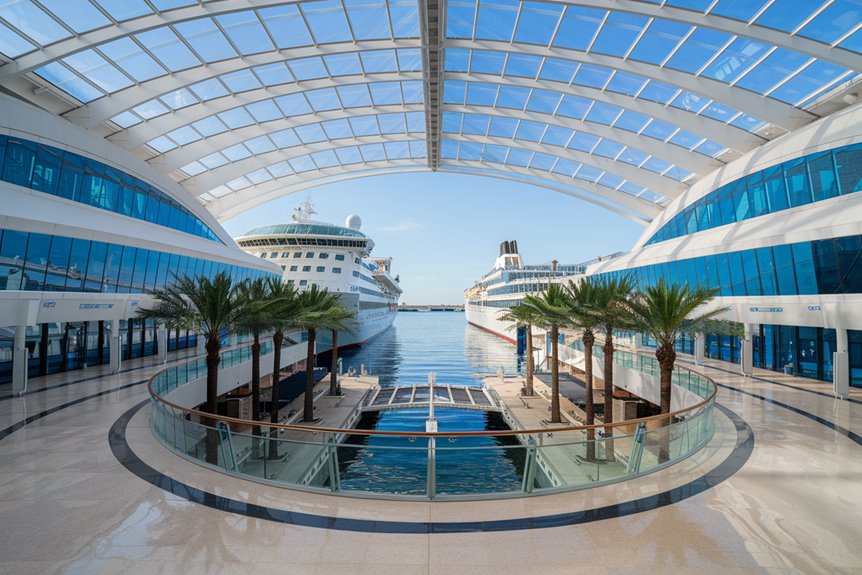
The cruise terminals at Marseille’s port have all the basics you’ll need: places to store your bags, spots to change money and free Wi-Fi throughout. You’ll spot clean loos, plenty of seating and help desks with staff who speak several languages. There are also some small shops where you can grab essentials or local keepsakes.
The main facilities at the terminals include:
- Security points with up-to-date scanning kit and trained staff for smooth, safe boarding
- Lots of check-in desks to handle several cruise departures at once, which means shorter queues during busy times
- Special help areas for people who need extra assistance, with wheelchairs and fast-track boarding
If you turn up early, you can settle into the air-conditioned waiting areas and pop into the small cafes for snacks and coffee.
Things to Do Before Your Cruise in a Day
Getting to Marseille a day early? You can fit loads of brilliant sights in before your cruise sets sail. Start at Notre-Dame de la Garde basilica – you’ll get amazing views of the city and the Mediterranean from up there. Then wander down to Le Panier district with its lovely narrow streets, where local artists sell their work and you can grab a coffee at charming little cafes.
Pop down to the Old Port (Vieux-Port) to see the fishing boats and treat yourself to some cracking fresh seafood at the waterfront restaurants. The MuCEM museum is worth a visit – it tells fascinating stories about Mediterranean history and culture. If you’ve got spare time, catch a boat to Château d’If, the famous old prison fortress. Need some last-minute bits? Le Panier’s small shops or the Terrasses du Port shopping centre near the cruise terminal should sort you out.
Walks near the port
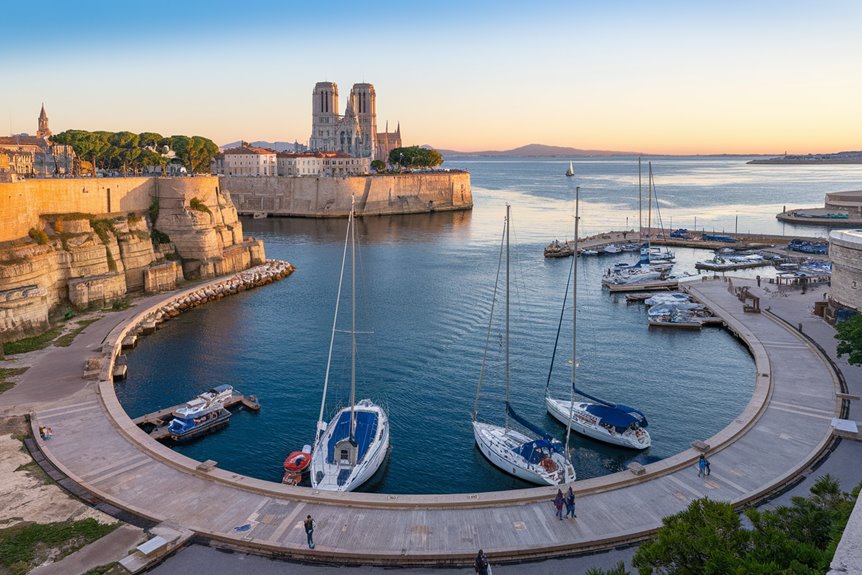
Several lovely walking routes start at the cruise terminal, letting you wander around Marseille’s lively waterfront. You’ll spot clearly marked paths heading to the old Panier neighbourhood, the busy Vieux-Port, and alongside the gorgeous Mediterranean coast. The routes are straightforward and give you brilliant chances for photos of both the city and sea.
- Walk the 20-minute waterfront path to Fort Saint-Jean for amazing views of the harbour and Notre-Dame de la Garde basilica
- Take the coastal route to Vallon des Auffes, a sweet little fishing port sitting under a limestone bridge
- Walk along the palm-lined Corniche Kennedy, popping into beach cafes and stopping at viewing spots on this 3km stretch
Most walks are flat and good for everyone, with lots of benches where you can take a break.
Dining and Shopping
Right near the cruise terminal, you’ll spot loads of shops and places to eat that show off Marseille’s lively Mediterranean way of life. The buzzing Le Panier area has local shops selling Provençal crafts, soaps and handmade bits and bobs, whilst the Centre Bourse mall has big-name brands and French fashion.
For proper local food, pop down to the Vieux-Port restaurants where you can try bouillabaisse, the city’s famous fish stew. The waterfront cafes are brilliant for fresh seafood and regional wines. Le Marché des Capucins, the city’s oldest food market, is great for tasting local cheeses, olives and spices. If you fancy a quick snack, grab a traditional navette biscuit from Four des Navettes or try some North African street food at Noailles market – it really shows off the city’s mix of cultures.
Accommodation near the port
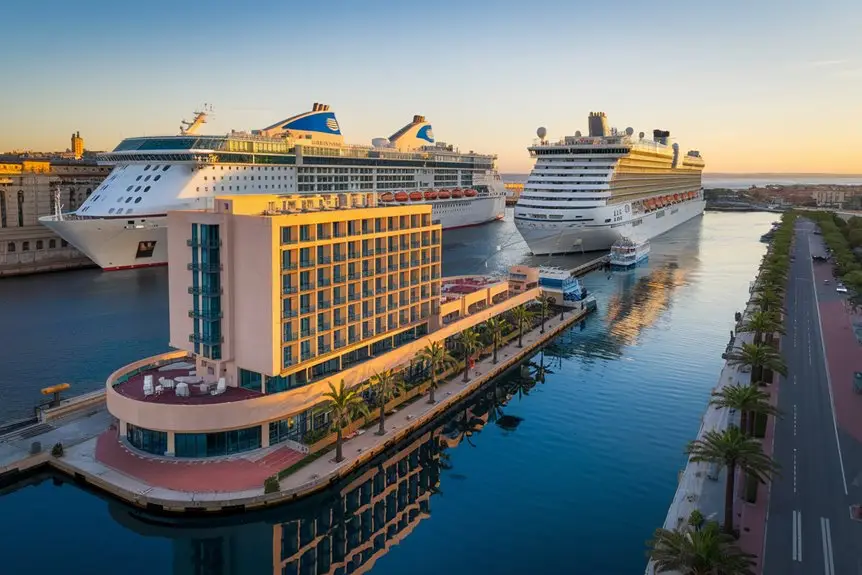
Looking for a place to stay near Marseille’s cruise port? There are loads of spots to choose from, with everything from posh hotels to simple hostels just a short walk from the terminals. The old Panier neighbourhood and Joliette area are your best bets if you want to be right by the port.
Want to make your cruise departure easier? Here’s what to know about staying near the port:
- Try hotels along La Joliette boulevard or rue de la République – they’re closest to the terminals
- Staying in Vieux-Port puts you near both the cruise port and main sights
- During busy cruise season (May-October), book at least 3 months ahead as places near the port get full fast
Many of the hotels by the water run shuttles to the cruise terminals – just remember to ask about this when you book your room.
Tips for First-Time Cruisers from The Port
Getting ready for your first cruise from Marseille’s port isn’t too tricky with a bit of planning. It’s best to show up a day early so any travel hiccups don’t mess up your cruise plans. Sort out your port transfer beforehand – taxis can be hard to find when it’s busy.
Look up your cruise line’s baggage rules and keep a small bag with your must-haves, since you might not see your main suitcase until the evening. Have your passport, boarding papers and cruise line’s health forms handy for check-in. Grab the port’s mobile app to see when ships come in and get updates straight away. Get some euros changed before you board for bits and bobs and tipping. Most important – remember when you need to be back on board – the ship won’t hang about if you’re late from day trips.
See what’s on offer from the Port of Villefranche-sur-Mer for a different Mediterranean cruise destination.
Customs & Immigration at The Port
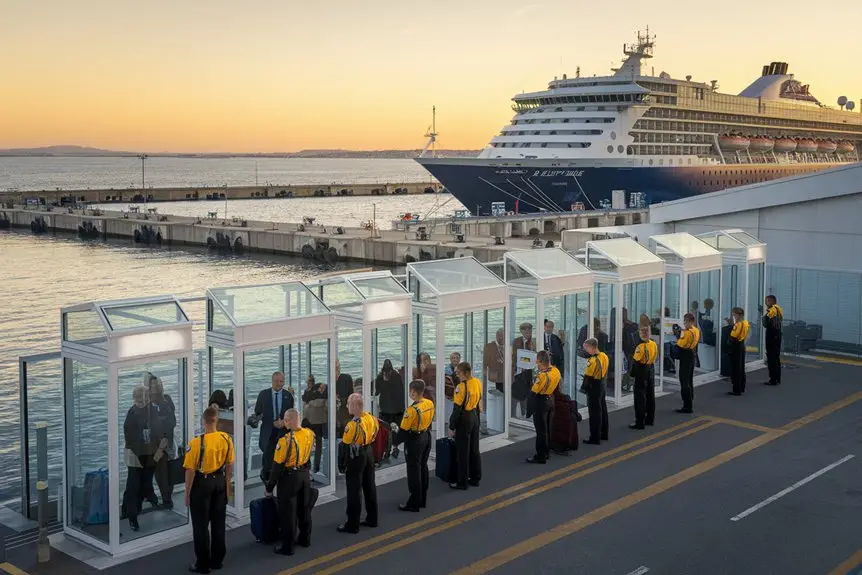
Getting through Marseille’s port customs means following France’s standard Schengen Zone rules. It usually takes 15-30 minutes – EU passport holders can use the quick automated gates. If you’re not from the EU, you’ll need to show your passport, cruise papers and any visas to the border staff.
What you need at Marseille port customs:
- Your passport should be valid for at least six months after your stay and have empty pages for stamps
- Your cruise card or ship ID along with your travel papers
- A customs form if you’re carrying over €10,000 in cash or any restricted items
Border staff might ask about how long you’re staying, your cruise schedule, or your travel plans home. If you’ve bought duty-free goods, make sure they match EU customs rules.
Local Currency & Payment Options
Money & Payments in Marseille
You’ll need to sort out your money when you arrive in Marseille. The Euro (€) is what’s used here, and you’ll spot cash machines at the cruise terminal and all over the city. Most places take credit cards, including shops, restaurants and taxis, but it’s smart to keep some cash handy for smaller bits and local markets.
You can swap your money at the terminal’s currency exchange, but you’ll usually get better rates at banks in town. Many people find it easier to just use their debit cards at cash machines to get Euros, as the rates tend to be better. Just let your bank know you’re travelling beforehand to avoid any bother with blocked cards. While some touristy spots might take US dollars, you’ll always get a better deal using Euros everywhere you go.
Emergency Contacts
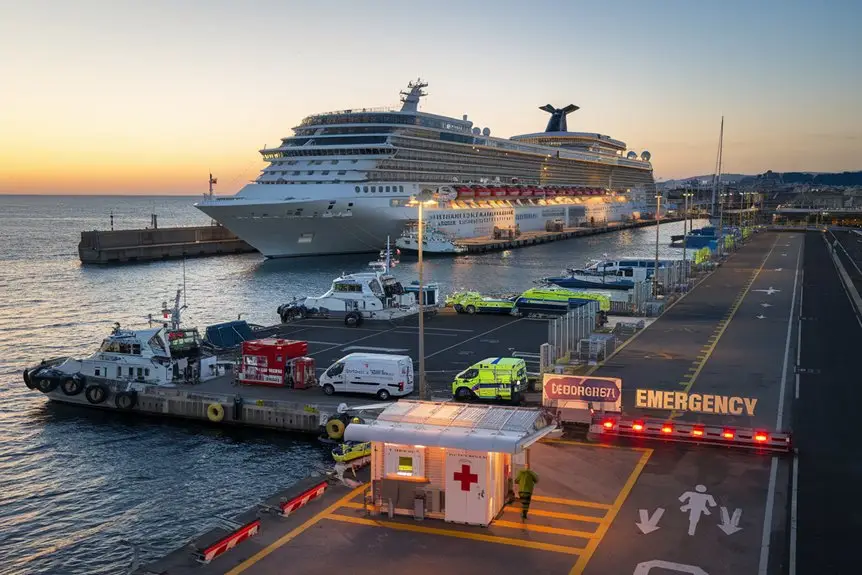
It’s crucial to have emergency numbers handy during your Marseille port visit. Pop these important numbers in your mobile and jot them down on paper too – you’ll be glad if your phone dies! For any emergency, ring 112 – that’s the European emergency number that connects you to police, medical help and fire services. You can reach the local police station near the cruise terminal on +33 4 96 11 30 00.
- Port Authority Emergency Line: +33 4 91 39 40 00 (running 24/7 for any port emergencies and help)
- Tourist Police: +33 4 91 14 65 30 (they’ve got English-speaking officers who know how to help visitors)
- U.S. Consulate in Marseille: +33 4 91 54 92 00 (for American citizens who need urgent consular help)
Don’t forget to save your cruise ship’s emergency number – you’ll get this when you board.
History of The Port
The ancient Greeks set up Marseille’s port in 600 BC, making what would grow into France’s oldest city. The port has been a crucial Mediterranean trading spot throughout history, linking Europe with North Africa and the Middle East.
In Roman times, the port grew loads bigger, and by the Middle Ages, it had become one of Europe’s biggest maritime hubs. The 19th century brought massive changes, with new basins and docks being built. The port kept growing in the 20th century, when they built the Marseille-Fos Port complex in the 1960s. These days, it’s France’s biggest port and the second-busiest cruise terminal in the Mediterranean, with more than 1.7 million passengers coming through each year.
Environmental Initiatives at The Port
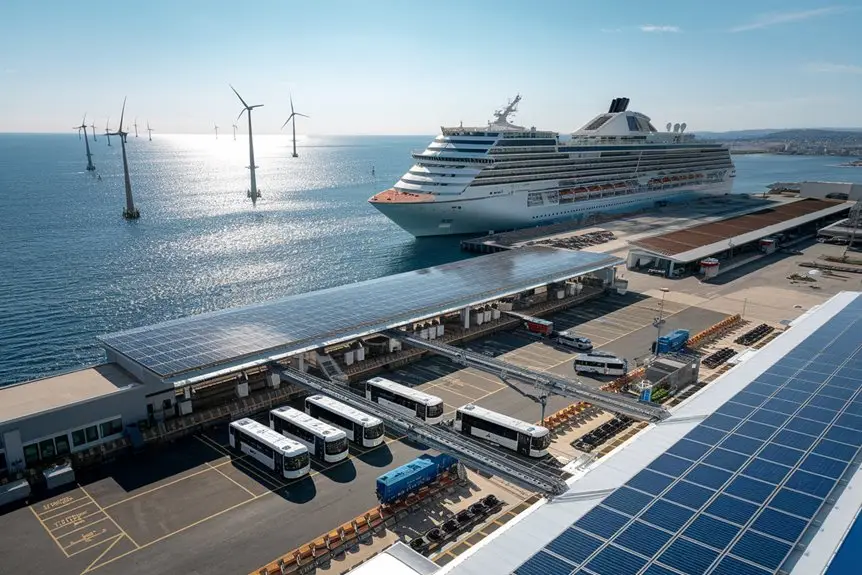
The Port of Marseille has really upped its environmental game since 2019 with some brilliant new projects. You’ll spot modern electric shore power points where cruise ships can plug in whilst they’re docked, cutting their emissions by 80%. They’ve also got a clever waste management centre that handles both solid and liquid waste from ships.
- Solar panels now cover the terminal roofs, generating enough electricity to power 30% of the port
- New water treatment systems are cleaning and recycling ships’ ballast water before it goes into the Mediterranean
- A special ‘Green Zone’ gives priority spots and cheaper rates to ships running on alternative fuels like LNG
Thanks to all this work, Marseille’s now known as one of Europe’s greenest cruise ports.
Accessibility Information for Disabled Passengers
The Marseille port does a good job with disabled passenger access. You’ll spot wheelchair ramps across all terminal buildings, and the ground stays flat and even from when you arrive until you board your ship. You can get free wheelchair help if you let your cruise line know beforehand.
All terminals have disabled toilets, lifts and special parking spots close to the entrances – you won’t need to walk more than 50 metres. Getting around is straightforward with the port’s shuttle buses, which all have hydraulic lifts and safe spots for wheelchairs. For anyone with sight problems, there’s tactile ground marking and Braille signs at important places. The port workers get special training to help passengers with different disabilities, and you’ll find them at info desks in every terminal ready to give you a hand with whatever you need.
Cruise Insurance and Medical Facilities at The Port
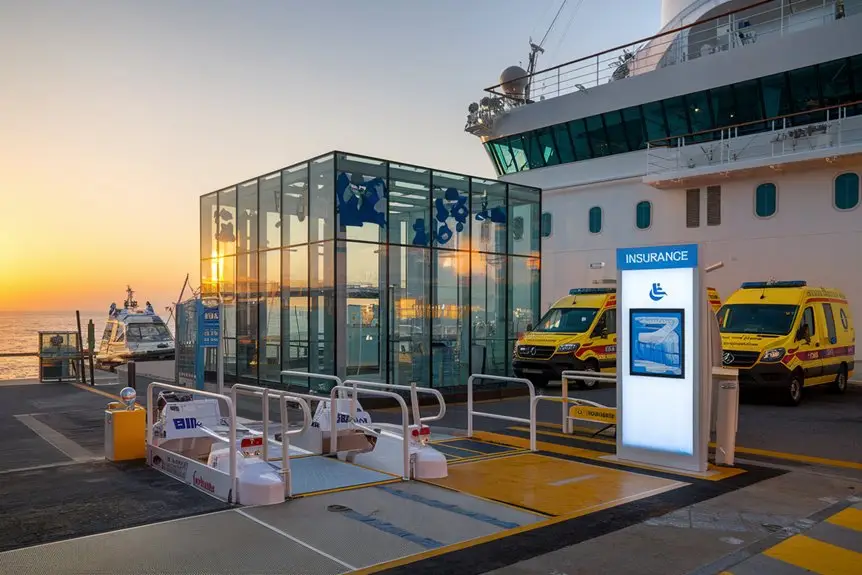
Medical care is sorted at Marseille’s cruise port – there’s a properly equipped medical centre running round-the-clock in Terminal 1. You’ll find doctors and nurses who speak English, plus emergency teams ready to help with any health worries before you get on or off your ship.
When sailing from Marseille, you need good travel insurance that covers medical problems at sea. The port suggests getting insurance that includes:
- Emergency medical evacuation worth at least €100,000
- Cover for existing health conditions and COVID-19 illness
- Direct billing set up with local hospitals in Mediterranean ports
The port’s medical centre can handle small injuries and give short-term care, but they’ll send serious cases to Marseille’s Hôpital Européen, which is just 10 minutes from the terminal.
Families: Child-Friendly Services and Activities
Travelling with kids in Marseille? The port terminals are really family-friendly. Both Terminal 1 and Terminal 2 have children’s areas with lots of toys and games for different ages. If you’ve got little ones, you’ll find baby changing stations and quiet nursing rooms in all the loos.
Pop down to the information desk to hire a pushchair, and you’ll spot loads of family-sized toilets across the buildings. Terminal 1 has a small arcade for the older children, plus free Wi-Fi spots to keep them entertained. In busy months, the port puts on activities like face painting and balloon making. The terminal’s restaurants can sort out special kids’ meals, and there are plenty of machines with snacks and drinks that children love.
Local Cultural Highlights and Events
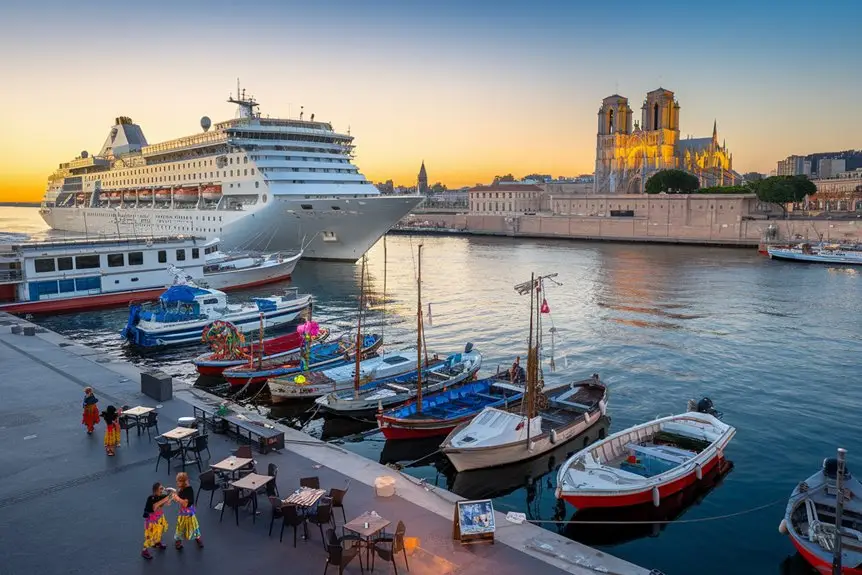
Marseille’s port area comes alive with cultural festivals and local celebrations all year round. You’ll find brilliant street shows throughout Le Panier district and hear traditional Provençal music at the Vieux-Port. From June to July, the Festival de Marseille fills the waterfront with modern dance and theatre shows.
- Pop along to the Fête du Panier in June, when local artists welcome you into their workshops and neighbours serve up proper Mediterranean food in the city’s oldest neighbourhood
- Join September’s Fête de la Vierge de la Garde, as locals walk to Notre-Dame basilica whilst boats decked in colours sail by
- Make time for December’s Santon Fair, where you can see Provence’s beloved hand-painted nativity figures – a tradition that started during the French Revolution
Best Times of Year to Cruise from The Port
The best time for your cruise from Marseille really depends on what you’re after. The main sailing season runs from April to October, with July and August being the hottest and busiest months. For lovely weather without the crowds, try May, June or September when it’s about 20-25°C.
If you’d rather save money and dodge the tourist rush, book for March-April or October-November. Winter cruises between December and February are cheapest, but it’s cooler and some places might be shut. Just remember the Mistral wind blows strongest in winter and early spring, which can make sailing a bit tricky.
Frequently Asked Questions
Are There Luggage Storage Facilities for Passengers Arriving Early at the Port?
Got somewhere to stow your bags? The cruise terminal has storage spots where you can keep your belongings safe if you arrive early. It’s handy and means you can wander around a bit before it’s time to board.
What Is the Typical Boarding Time Before Cruise Departure?
You’ll generally want to get to your ship about 2-3 hours ahead of sailing time. Most cruise lines begin letting passengers on around midday for afternoon departures, but the exact timing can be different depending on which company you’re travelling with.
Can Passengers Send Mail or Postcards From the Cruise Terminal?
The cruise terminal doesn’t have a post office or mail service. If you want to send postcards or letters, you’ll need to pop into a post office in Marseille city centre before you get on your ship.
Are There Prayer Rooms or Religious Facilities at the Terminal?
There aren’t any prayer rooms in the terminal. While you won’t find a dedicated religious space inside, Notre-Dame de la Garde basilica is just a few minutes’ walk away if you fancy visiting during your stay at the port.
What Water Sports Activities Are Available Directly From the Cruise Port?
You can’t do water sports right at the cruise port itself. For activities like kayaking, snorkelling, or jet skiing, you’ll need to head to the local beaches or book through your ship’s day trips.
Thinking about something different? Check out the cruises leaving from Nice Cruise Ship Port.
